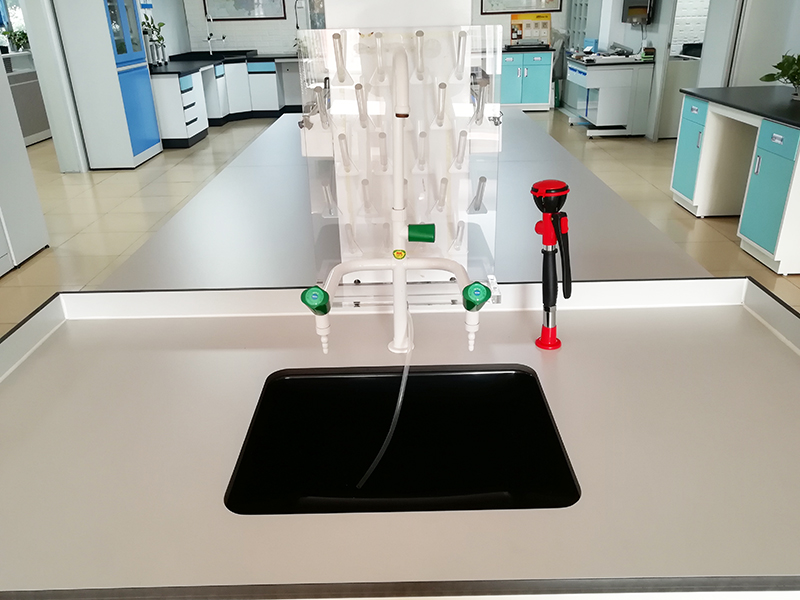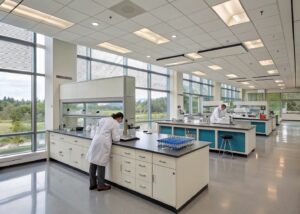Why Use Specialized Lab Furniture For Chemistry Lab?
Specialized lab furniture is crucial for chemistry labs due to the unique demands of the environment. Chemistry labs involve handling various chemicals, some of which can be hazardous. Specialized lab furniture is designed to withstand these challenges, ensuring safety, efficiency, and longevity.
Safety: Lab furniture must be resistant to chemicals, heat, and fire to prevent accidents. For example, fume hoods are essential for ventilating harmful fumes, while chemical-resistant countertops prevent corrosion.
Efficiency: Properly designed lab furniture enhances workflow. Ergonomically designed benches and adjustable stools help reduce strain and fatigue, allowing lab personnel to work comfortably for extended periods.
Durability: Unlike regular furniture, lab furniture is built to endure the harsh conditions of a chemistry lab. This durability ensures a longer lifespan, providing better value over time.
What Is The Optional Materials For Chemistry Lab?
Selecting the right materials for lab furniture is essential for ensuring safety and durability. Here are some of the best materials for chemistry lab furniture:
Stainless Steel: Known for its durability and resistance to corrosion, stainless steel is ideal for lab benches, cabinets, and sinks. It is easy to clean and can withstand exposure to various chemicals.
Epoxy Resin: This material is highly resistant to chemicals, heat, and moisture, making it perfect for countertops. Epoxy resin surfaces are non-porous, preventing chemical absorption and making them easy to clean.
Phenolic Resin: Similar to epoxy resin, phenolic resin is highly resistant to chemicals and heat. It is also lightweight, making it suitable for mobile lab furniture.
About epoxy resin and phenolic resin, more details, please refer to this article :
Polypropylene: Often used for storage cabinets and shelving, polypropylene is resistant to most chemicals and is easy to clean.
What Lab Furniture and Equipment Will Use In The Chemistry Lab?
A well-equipped chemistry lab requires various types of furniture and equipment to support different functions. Here are the essential pieces:
Laboratory Benches: The backbone of any lab, these benches are used for conducting experiments, preparing samples, and analyzing results. They often come with built-in sinks, gas fixtures, and electrical outlets.
Chemical Storage Cabinets: These are designed to store chemicals safely. They are often made from materials that resist corrosion and are equipped with ventilation to prevent the buildup of harmful fumes.
Fume Hoods: Essential for protecting lab personnel from inhaling hazardous fumes, fume hoods provide proper ventilation and containment of dangerous substances.
Shelving Units: These are used for storing glassware, instruments, and other lab supplies. Adjustable shelves allow for flexible storage options.
Lab Stools and Chairs: Designed for comfort and ergonomics, these pieces of furniture are adjustable and often made from anti-static materials.
Eye Washer or Emergency Shower: Eye washers and emergency showers are critical safety fixtures in chemistry labs. Eye washers are designed to flush harmful chemicals or particles from the eyes, providing immediate relief and preventing serious injury.
What We Should Pay Attention To When Use Chemistry Lab Furniture?
When using chemistry lab furniture, several key considerations ensure safety and longevity:
Proper Maintenance: Regular cleaning and maintenance are crucial. Use appropriate cleaning agents that won’t damage the furniture’s material.
Chemical Compatibility: Ensure that the furniture materials are compatible with the chemicals used in your lab to prevent damage and ensure safety.
Weight Limits: Be mindful of the weight limits of benches and shelves to avoid overloading, which can lead to accidents or damage.
Ergonomics: Adjust furniture to the appropriate height and position to prevent strain and injury. Ergonomically designed furniture can significantly improve comfort and productivity.
Is Chemistry Lab Furniture Easy To Damage?
While chemistry lab furniture is designed to be durable, it can still be damaged if not used or maintained properly. The following factors can contribute to damage:
Chemical Spills: Accidental spills of corrosive chemicals can damage surfaces if not cleaned promptly.
Improper Cleaning: Using harsh or incompatible cleaning agents can degrade the material of the furniture over time.
Overloading: Exceeding the weight limits of benches and shelves can cause structural damage.
Improper Use: Using furniture for purposes other than its intended use can lead to wear and tear. For example, using a lab bench as a makeshift storage area for heavy equipment can cause damage.
How To Choose The Chemistry Lab Furniture?
Choosing the right chemistry lab furniture involves several key considerations:
Assess Your Needs: Determine the specific requirements of your lab. Consider the types of experiments conducted, the chemicals used, and the number of personnel.
Material Selection: Choose materials that are resistant to the chemicals used in your lab and that can withstand the lab environment.
Customization Options: Opt for furniture that can be customized to fit your lab’s specific needs. This includes adjustable benches, modular storage units, and mobile furniture.
Compliance with Standards: Ensure that the furniture meets industry standards and regulations for safety and performance.
Supplier Reputation: Choose a reputable supplier known for quality and reliability. Look for reviews and testimonials from other customers.
Budget Considerations: While it’s essential to invest in high-quality furniture, it’s also important to stay within budget. Compare prices and features to find the best value for your money.
More details about how to choose the lab furniture, please refer to this article:
The Ultimate Guide To Choosing The Best Lab Furniture For Your Needs
Investing in high-quality chemistry lab furniture is essential for ensuring a safe, efficient, and productive lab environment. By considering the specific needs of your lab and choosing the right materials and designs, you can create a workspace that meets all safety standards and enhances workflow.




